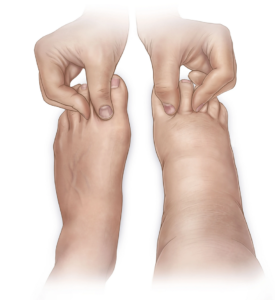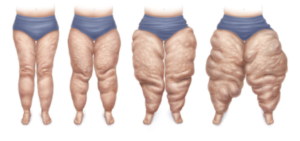Lipoedema is a chronic, progressive disorder that is characterized by abnormal distribution of adipose tissue. This results in disproportion between extremities and trunk. The disproportion is caused by a localised, symmetrical increase in subcutaneous adipose tissue, typically in the lower extremities, less common also in the upper extremities. Compression wear is one very important element in the treatment of lipoedema.
Are you constantly gaining weight in both legs, buttock and/or arms that won’t go away even with the strictest diet?
Do the affected areas bruise easily, feel softer and cooler than unaffected areas, and are extremely sensitive to touch?
If so, you might have developed lipoedema. Read here what other signs could indicate lipoedema, why compression can be helpful in treatment of lipoedema and what other treatment options exist.
What is lipedema?
Big legs, protruding buttocks – often, lipedema is wrongly judged as being overweight or obese. But lipedema has nothing to do with being overweight. Lipedema is the result of a pathological build-up of fat cells in the extremities. Typically, it affects the legs. Since lipedema occurs almost exclusively in women, experts assume hormonal causes. test
Despite a conscious diet and exercise, the affected women typically gain weight in their legs and/or, less commonly, arms. The increased accumulation of fat cells cannot be reduced by calorie reduction.
What is the cause of lipedema?
There is no exhaustive research on lipedema yet. One thing is certain though – this chronic disease is not caused by improper nutrition or excessive food intake. Experts presume a genetic predisposition as well as hormonal triggers.
Lipedema often starts during puberty. However, oral contraceptive use, pregnancy, and menopause also seem to be triggers. In men, lipedema-like changes have only been described in the context of hormonally active therapeutic agents, pronounced hormone imbalances (for example, hypogonadism), or liver cirrhosis.
Types of lipoedema
Lipoedema consists of 5 major types, with types 1 to 3 being the most common. It is important to note that individual patients can present with a mixture of types:
- Type 1: pelvis, buttocks, and hips
- Type 2: buttocks to knees, with formation of folds of fat around the inner side of the knees
- Type 3: buttocks to ankles
- Type 4: arms
- Type 5: lower legs
What are the signs and symptoms of lipedema?
- Considerable tissue enlargement; usually bilateral and symmetrical without involvement of the hands and feet. The pattern of affected areas may vary from patient to patient. It most commonly affects the legs, thighs, hips, and/or buttocks, but it can also affect the arms.
- Pain and extreme sensitivity/tenderness to touch and pressure in the affected areas.
- Swelling and feeling of heaviness in the affected limbs.
- Limited mobility, muscle weakness.
- Cuffing or “braceleting” at the ankles/wrists: The tissue enlargement stops abruptly at the ankles or wrists so that there is a “step” before the feet or hands which are usually unaffected.
- In lower-limb lipedema, loss of the concave spaces on either side of the Achilles tendon.
- Tendency to easily bruise: May occur anywhere in areas affected by lipedema without any apparent cause.
- Altered skin appearance, temperature, and texture: Softer and cooler skin in comparison to unaffected areas; texture of orange peel or with larger dimples.
- Abnormal gait, limited mobility, and muscle weakness.
- Stemmer’s sign is negative. This means that a fold of skin can be pinched and lifted up at the base of the second toe or at the base of the middle finger.

- Pitting edema (in patients with lipedema or lipo-lymphedema and/or CVI): Usually absent in the early stages; indicates the presence of excess interstitial fluid.
The stages of lipedema
Experts divide lipoedema into three stages. Symptoms of lipoedema can vary greatly from person to person – not all patients, for example, reach stage three.
Stage I: The skin appears smooth. If pressed on, uniformly thickened subcutaneous tissue with soft consistency.
Stage II: The skin shows an irregular texture that resembles the skin of an orange. Subcutaneous nodules that vary in size are palpable.
Stage III: The volume increase of the subcutaneous fat tissue has progressed further with larger and more prominent indurations than in Stage II. Deformed lobular fat deposits that may cause considerable distortion of the limb profile are present.
(Stage IV: Involves the presence of lipo-lymphoedema)
 Disease mechanisms for lipoedema
Disease mechanisms for lipoedema
Disease mechanisms include:
- Enlargement of fat tissue either by adipocyte hypertrophy (increase in size, but not in number, of fat cells) or by adipocyte hyperplasia (increase in number of fat cells).
- Oxygen deficiency in fat tissue might contribute to the easy bruising often reported by lipedema patients.
- Reduced skin and connective tissue elasticity.
- Compression of nerve fibers by enlarged fat deposits and/or inflammation may be the cause of pain and hypersensitivity seen in lipedema patients.
- Development of edema (swelling). Lipedema is often accompanied by the formation of fluid oedema (lipo-lymphoedema). This may result from increased interstitial fluid formation due to capillary fragility, mechanical obstruction of small lymphatic vessels by adipose tissue enlargement, reduced skin and connective tissue elasticity, and reduced mobility due to pain or joint problems.
Can I prevent lipedema?
Since the causes of lipedema have not been conclusively determined, there are no preventive measures either.
Weight can aggravate the symptoms and favor the progression of the disease, therefore a healthy diet may have a positive influence.
What can I do about lipedema?
Have you been diagnosed with lipedema? This chronic, progressive disorder is marked by the individual variability and unpredictability of its clinical course.
Therefore, treatment consists of several therapeutic approaches that should be combined as necessary.
Physical therapy
Manual lymphatic drainage helps to activate the lymphatic vessels and to ensure faster drainage of the lymphatic fluid. This reduces swelling in the legs. Also, the use of compression wear helps by reducing the development of swelling and the painful sensation. Exercise and skin care are also important parts of physical therapy.
Physical activity
Exercise, such as walking, swimming, or hiking, are good for body and mind and help to alleviate discomfort.
Psychotherapy
The psychological strain of living with lipedema can be considerable. They may hear snide remarks: eat less, exercise more… Statements like these could further reduce their self-esteem; the stress could lead to depression and eating disorders. A person with lipedema may feel insecure about his or her appearance and experience a loss of self-esteem. In some cases, these feelings can lead to depression, eating disorders, and other psychological problems. Psychotherapy may be recommended to help build coping skills.
Liposuction and plastic surgery
Surgery is indicated if, despite thorough conservative treatment, symptoms persist or worsen. If present, morbid obesity should be therapeutically addressed prior to liposuction. Following liposuction, patients should wear compression garments for several weeks.
